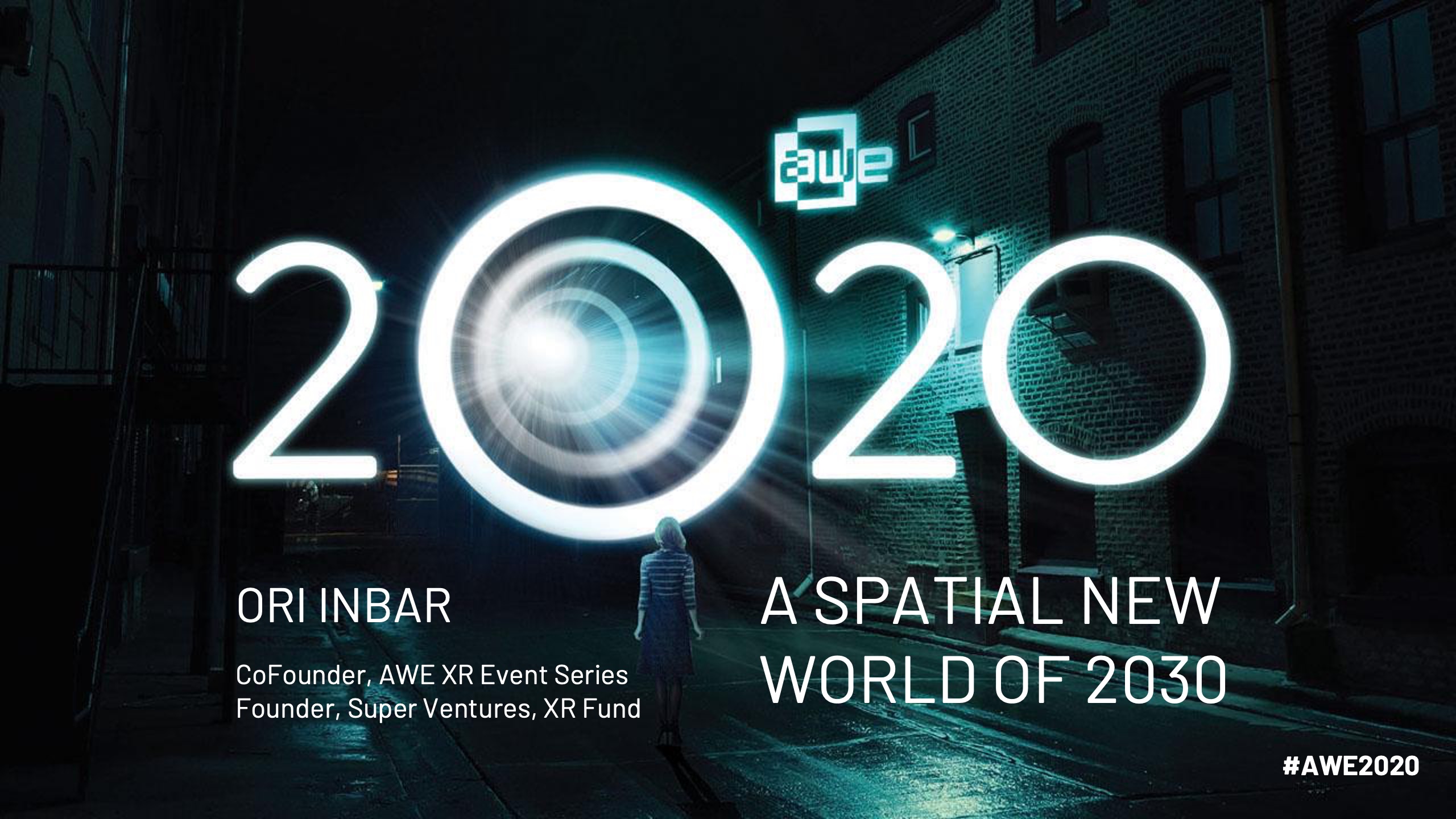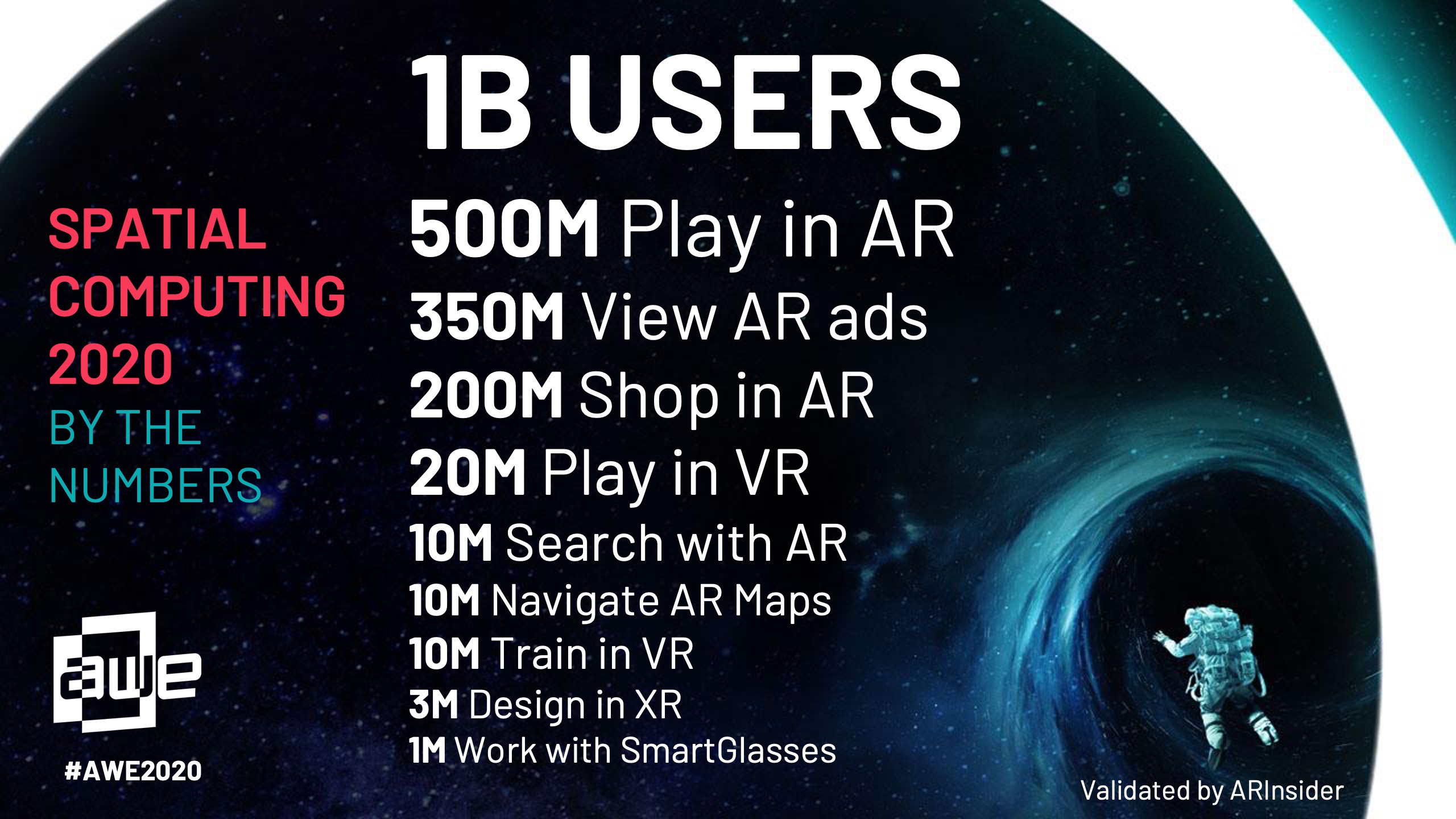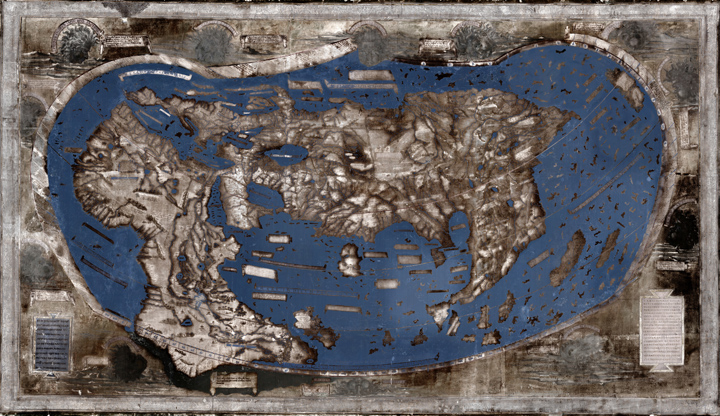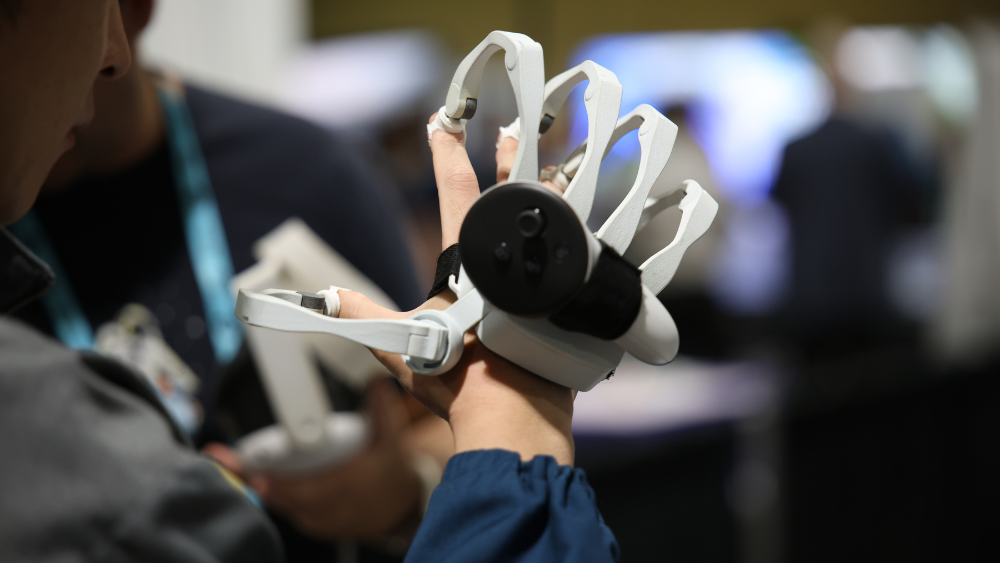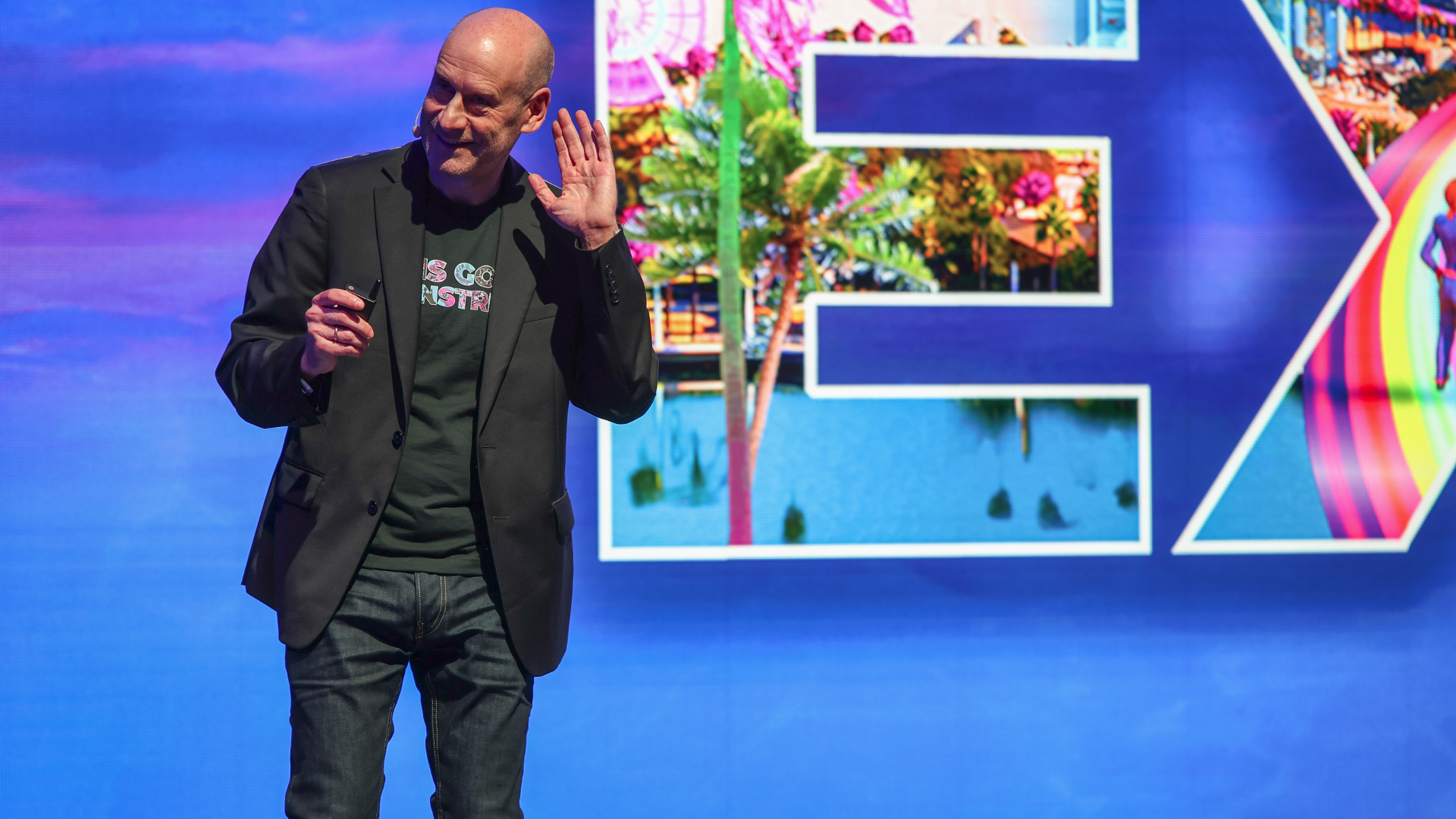AWE 2020 Opening Keynote
Spatial New World: Envisioning the Impact of Spatial Computing on our lives in 2030
(Transcript)
Welcome everyone to the 11th year of AWE!
For the first time ever - we will join AWE from home...and It’s awesome to have you join us from around the world.
These are challenging times, so now, more than ever - it’s time to go spatial!
The Spatial Computing industry has hit a major milestone in 2020. XR adoption is at an all time high:
Since 2010, AWE’s mission has been to nurture an environment for the AR and VR industry to accelerate the adoption by the mainstream.
Now that we are there, it’s time to turn our attention to the next decade. We hope you will all join us in our quest to make Spatial Computing an essential part of everyone’s life and work, and preparing society for it.
To align our views of the future we wish to discuss The Spatial New World of 2030.
But instead of me talking about it, I’ll share a message I got from the future.
This past February after the CDC warned “it's not a question of if, but when the coronavirus will spread”, I got a message from my future-self in 2030...
***
“Hey Ori, it’s me - your future-self from 2030.
Back in 2020, you are facing a devastating global pandemic - but don’t worry...it will pass. I am sending this message to encourage you and the AWE community to continue on your long and bumpy road to bringing -- what you used to call Augmented and Virtual Reality -- to the mainstream. In fact, you are about to see an unprecedented acceleration of this technology. By now in 2030, everyone is using it as an essential part of their daily lives and can’t even recall a time when it wasn’t the case. Almost nothing works without it. Tell your audience they should be proud and to never never never give up!
I am testing this feature of The Quantum Internet (1) where I can manipulate photons across time (2) to send you this message - pretty cool stuff.
I can’t tell you much about your future because as Stephen King said: the past doesn’t want to change (3).
What I can tell you though is about how your industry has impacted life in 2030. As the old adage goes: If you know where you are going, you have more confidence in taking the next step.
Here in 2030, we are still battling major threats that are assaulting our planet...but we got lifesaving help thanks to the wide adoption of Spatial Artificial Intelligence. SPatial Artificial Intelligence (or Spai as I like to call it) is the fusion of tech including AR, VR and AI and serves as a common foundation for iOT, robotics and autonomous vehicles. This infrastructure became critical to make the world function. With SPAI, humanity has been transformed and is more equipped than ever to handle the existential crises we are facing.
As machines are inching towards human level intelligence, we try to understand what it means to be human in a machine-led world(4). Just like Kevin Kelly predicted, we are living through a constant identity crisis: what are humans for?
Humanity has changed more in the past 10 years than in all of human history!
...OK, maybe it has a touch of hyperbole, but hear me out:
Since 2020, half of all traditional colleges(5) and corporations ceased to exist and a third of all jobs are now gone(6)(7). Most lost jobs were replaced by new ones that were recently invented. And with JITT (Just In Time Training(8) based on SPAI) millions are being quickly reskilled to fill these new jobs; a process that repeats almost every 18 months. And because employees can live where they want and access any job anywhere, unemployment is at its lowest. Thanks to the productivity gains the work week has shrunk to 4 days, yay!
The new jobs rely on inherent human traits like empathy, creativity, entrepreneurship & innovation, ethics, and emotional intelligence(9). It’ll take more time for AI to catch up on these hard to copy human abilities.
So far, Augmented Humans still have an edge over Replaced Humans (or machines.)
And surprise surprise - most of the workforce is...women. It turns out women are better than men at these new kinds of jobs...(10)
Yet, for those who naturally lack empathy and creativity skills, Spai helps to stay competitive in the workplace.
Since 1 in every 5 residents is in retirement age today, many of the newly created jobs are to care for fellow human beings with the assistance of SPAI-based applications that improve and extend quality of life.
How big is the SPAI market?
Well, 3 billion people are using it daily (they can’t leave home without it) and global spend on Spai has crossed 1 trillion dollars! Yes!
Who’s using it and for what?
We are now truly living in the Experience Economy(11). With Spai the experience is the product, before, during and after you buy it. We immerse-shop from home or go on location-based shopping experiences.
We socialize, play, create, entertain, cook, groom, travel, and do sports - we do it all through Spai.
For businesses, across all industries it’s as indispensable as ERP systems were in the 90’s but infinitely more powerful: it has proven business efficiencies upwards of 20% - across the board - from HR, to design, production, distribution, sales and marketing, while reducing costs and raising safety across the entire supply chain.
99% of all businesses use Spai.
In total, the impact of Spatial computing has boosted the global economy by 1.5 trillion dollars (12)!
Still, there is a significant digital divide. But it’s encouraging that the industry is behind the aspiration to reach every single person of the 8.5 billion people(13) on this planet. And it’s driven by a simple proven fact: the more diverse SPAI is - the more it resembles reality - and that’s a goal we all share.
The changes in Healthcare were spectacular: costs have gone down by half and with better outcomes. That’s thanks to personalized and preventive medicine as well as telehealth services; once again SPAI was a key contributor.
It also brought high quality healthcare to remote and underserved populations, and in some areas life expectancy has risen by 20%.
Mental illness which has emerged as top global health burden on society(14) is being prevented and treated with SPai based applications with resounding success, establishing spai as a juggernaut of social good.
SPAI unlocked another achievement in society: fatal accidents(15) and fatal crimes(16) have been cut by half. Not too shabby.
Climat Change
And yet, the biggest boss fight of all time is the fight against climate change…it seems like the 2020 pandemic was just the prequel to the global climate crisis(17). But Spai visualizes the invisible threats which elicits a visceral reaction. When you see how every action you take will impact climate change - it makes you think twice before you act. And everyone instantly becomes an activist.
We were able to change the behavior of billions of people as well as influence governments' and corporate policies. We entered a new era for business(18); shareholder return is no longer seen as its only goal. Corporations are accountable for how their approach to sustainability and society, and those who do - are celebrated by everyone from mainstreet to Wall Street(19).
We are seeing a lot more floods, fires, storms(20) but Spai helped develop better solutions for disaster relief and emergency response. It’s literally saving the day.
Spai even transformed waste: Today, any physical consumer good that can be replaced by a virtual good - is being replaced(21). Manufacturing of gadgets, toys, art, even fast fashion (things you wear once to show off on social) -- were largely replaced by digital things that look, feel and behave like the real thing. That helped reduce manufactured waste by half!
In fact, we have replaced many of our physical activities with a lower-carbon virtual alternative. Fossil fuel-based travel has been reduced dramatically.
2020 will live in infamy as the “lost year”, but on the positive side, the pandemic generated an Explosion of Awareness(22) to remote meetings and virtual collaboration tools, and since then - the growth in adoption never slowed down.
Distance was eliminated.
Form Factor
The 2020’s were marked with tons of innovation in biology and genetics, but after some alarming blunders with genetic engineering aimed to augment humans, it became highly regulated, and slowed it down to a crawl.
SPAI became the safe non-intrusive way to amplify human intelligence. It enhances our natural senses, sight, hearing, touch - and yet can be disconnected at will. To be frank, most of us rarely disconnect, but it’s comforting to know it’s (still) possible.
You are probably wondering how we interface with SPAI, right?
In the last few years, Lightfield Retina Projections (Lirps in short) became the most ubiquitous form factor and can be seen on every face and in every room, office, and public space. Let me put it this way - there are more Lirps sold than smartphones, TVs, monitors, and computers combined...
These affordable and irresistible devices, available with your favorite fashion brands, track your pupils and project 3-Dimensional imagery straight into your retinas. We aren’t concerned anymore with limitations of eye-box, field of view, resolution, focus and brightness, since for our brains it is indistinguishable from photons; it’s on par with natural vision.
If this seems far-fetched to you, keep in mind in 2020 all the ingredients were already there. You were facing some formidable obstacles to deliver on a consumer product…but you pulled through. It’s here - thank you!
Oh, and since it’s not spraying photons all over the place the energy consumption is low and we do not need to worry about charging devices anymore!
The dirty secret is that data centers are now responsible for most of the heavy-lifting related to SPAI (even with Neuromorphic chips(23) which improve AI processing efficiency), and they now consume 8% of the global electricity usage!
Luckily, they aim to rely on 100% renewable energy.
The Lirps are complemented with sensor arrays. We wear them or embed them in our surroundings. Some even implant them, though most still prefer the option to disconnect. Bio sensors allow us to naturally interact with the world around us. Controlling experiences is as natural as it was for cavemen: we use our voice, eyes, hands, body, or brain…The keyboard and mouse went the way of the Blackberry.
Scanning sensors constantly inspect everything and everywhere for places, objects and people. They help us perceive shapes, textures, sounds, temperatures - the weather(24), and specialized scanners identify smells, waves, particles, and any other invisible or hidden phenomena that we wish to make visible.
Think about it: In 2020 we were only able to see less than 1% of the electromagnetic light spectrum, and could hear only a tiny sliver of sound waves(25).
For all practical purposes we were considered deaf and blind!
Now, if we choose to - we can see, hear, or sense it all!
We perceive reality with astonishing clarity.
Network Infrastructure
5G was a game changer, but it’s so 2020’s...6G is the new kid on the block, bringing a ten-fold boost in data transfer(26). It can now connect not billions, but trillions of objects in IOT. 6G serves pre-processed pre-rendered imagery straight into any Lirps in just a few milliseconds. As a result, none of the processing or rendering still happens on devices. It made Lirps and sensors almost disappear into thin air.
Massive crowd-sourcing is continuously 3D-fying the entire world, so now 95% of all streets and places are freshly available for persistent augmentation. And guess what? Thanks to heroic efforts by standards organizations(27) and activists - it’s all open, interoperable and accessible through a Spatial Discovery Service from any device.
Well, most of it is open. I guess walled gardens never die, they just get replaced.
AR vs VR?
Oh, remember the time when you were debating AR vs. VR in the teen years? It is now really a moot point: it’s simply a question of how much of reality you choose to cover, then adjust the opacity on your device…
The only question is whether you want to be in the now (and interact with whom or what’s in front of you) or be transported into a different place or time. If you want both: no problem - simply enter the realm of shared presence.
Creativity
Over the past decade a new visual language was invented and ushered an explosion of creativity. Children have “imagination machines” on their faces(28), and intuitive creation tools are abundant. Just like in 2020 everyone had the tools to create highly shareable video content, today everyone is able to create 3 dimensional spatial content that seamlessly integrates with the real world, or a fantasy world. And it’s as easy as shaping play doh if it had a copy-paste-delete-undo-color-scale...etc menu.
Utopia?
Don’t get me wrong, not everything is rosy. There is a perpetual tension between truth and fiction. Seeing is no longer believing. Remember the game Real or AR(29) where a video would be posted asking people to guess if the object is real or augmented? That was a cute game. Today we literally can’t trust our senses. SPAI allowed deep fakes to infiltrate our retinas. It’s true that it’s also helping detect deep fakes and warn us about their presence, but these are very confusing times. One of the definitions of sanity is the ability to tell real from unreal. At this point, we may need a new definition(30).
It reminds me of the great sci-fi novel from 100 year ago, Brave New World, which was about the choice between Truth or Happiness. Aldous Huxley depicted a dystopian state that imposed happiness on its society while compromising truth. Today, in the Spatial New World, reality is strained between 2 dimensions: transparency (truth) and make belief (fiction) and every moment of every day, a war is being waged between these two constructs.
The good news is that Teenagers today are nurtured to be more visually perceptive than generation X. It’s thanks to the radical changes in education: the scope of literacy has expanded beyond STEM to include spatial and visual literacy - which equips them with the skills to survive the confusing new reality.
Are we happier? Most of us are able to make our lives mirror our imagination which is awesome. But is it really our own imagination?
The question of free will is often debated: How do you know what you really want? Did it come from inside of you or was it a result of an external manipulation(31)?
What’s up with privacy in 2030?
The Internet of Eyes is here - over 10 billion connected cameras(32) constantly record and analyze our every move.
So you may be surprised that privacy is not a top consumer concern in 2030.
And it’s for a simple reason: Companies no longer compete on selling you as a product;
They now compete on privacy. Privacy considerations are architected into the Spai foundation and are ingrained in every product.
Here’s an example, when you perform a task in the real world (like operating a coffee machine, or fixing your sink) the steps are automatically captured through the camera and sensors, while stripping out all personal information. The know-how is aggregated across many users in a knowledge-base, that helps other people visually troubleshoot similar tasks. With Spai, crowd-sourced knowledge creation about how the world works a privacy-friendly business model.
And as a result, the largest internet company in 2030 became no. 1 without exploiting user information. But by trading in knowledge, aggregated through SPAI.
But like with any technology, bad actors can exploit it too: Spai made hackers way more powerful. Digi-pandemics are all the rage; you’ll see it when you get here...
That’s my message for you. Don’t ask me about the winners because I can’t share names. Remember, the past doesn't want to change. What I can say is that the biggest internet company in 2030 is one that you’ve never heard of and it’s an education company(33).
Before I go, I have a confession...I'm actually not from the future. I'm your subconscious, you see?
Everything I told you today, you already knew...good bye and keep up going spatial!”
***
A Map for the Future
Ah, of course…
Fellow XR professionals, these are not meant to be predictions. The above is a possible scenario, based on current trends and research (see footer), to help pave the path forward, to make smarter, better-informed decisions for the future.
Keep in mind, this future is not inevitable...what happens depends on what we do. Use this story as a rough map.
It's not meant to be a perfect map. In 1492, the cartographer Martellus made a far-from-perfect map of the globe. And yet it was good enough to guide the great explorers to discover the new world(34).
This is a call to share your maps, and work together to debate and align our maps (while uncovering more detail) so that we take the journey towards the future of Spatial Computing on a common path, and discover a Spatial New World that we all want to live in.
Despite everything that is happening right now in the world, 2020 is a good year for Spatial Computing.
And we have assembled for you a fantastic collection of exhibitors and speakers across the industry so you can learn, get inspired and interact with your peer XR professionals.
Many thanks to our sponsors and have a great week -- at AWE from home!
Yours,
Ori Inbar
Cofounder of AWE
***
REFERENCES
1. Quantum Internet https://www.wired.com/story/quantum-internet-is-13-years-away-wait-whats-quantum-internet/
2. Quantum Entangled Time https://www.sciencealert.com/if-you-thought-quantum-mechanics-was-weird-wait-til-you-check-out-entangled-time
3. Stephen King 11/22/63 https://www.goodreads.com/work/quotes/15553789-eleven-twenty-two-sixty-three?page=8
5. Clayton Christensen https://www.cnbc.com/2018/08/30/hbs-prof-says-half-of-us-colleges-will-be-bankrupt-in-10-to-15-years.html
6. https://www.pwc.com/hu/hu/kiadvanyok/assets/pdf/impact_of_automation_on_jobs.pdf
7. McKinsey Future of Work https://www.mckinsey.com/~/media/mckinsey/featured%20insights/Future%20of%20Organizations/What%20the%20future%20of%20work%20will%20mean%20for%20jobs%20skills%20and%20wages/MGI-Jobs-Lost-Jobs-Gained-Report-December-6-2017.ashx
8. JITT in Rainbows End by Vernor Vinge
9. Quote from Anders Sorman-Nilsson
10. Mckinsey The future of Women at Work https://www.mckinsey.com/featured-insights/gender-equality/the-future-of-women-at-work-transitions-in-the-age-of-automation
11. The Experience Economy: https://hbr.org/1998/07/welcome-to-the-experience-economy
12. PwC Report: https://www.pwc.com/seeingisbelieving
13. UN projects world population to reach 8.5 billion by 2030 https://www.un.org/sustainabledevelopment/blog/2015/07/un-projects-world-population-to-reach-8-5-billion-by-2030-driven-by-growth-in-developing-countries/
14. Mental Illness Burden https://www.ncbi.nlm.nih.gov/pmc/articles/PMC4767178/
15. https://www.who.int/news-room/fact-sheets/detail/road-traffic-injuries
16. https://www.futuretimeline.net/21stcentury/2030.htm#crime
17. Rutger Bregman https://time.com/5833427/coronavirus-hope/
18. BCG: Winning the 20’s https://bcghendersoninstitute.com/winning-the-20s-optimize-for-both-social-and-business-value-beyond-shareholder-value-15d794892880
19. HBR: The Investor Revolution https://hbr.org/2019/05/the-investor-revolution
20. Annalee Newitz MIT technology review https://www.technologyreview.com/2020/02/26/905703/professionals-who-predict-the-future-for-a-living-forecasting-futurists/
21. Lotfi Belkhir https://www.ecowatch.com/amp/smartphones-heating-up-the-planet-2553238059
22. Reference to Astronaut Edgar Mitchell
24. https://www.futuretimeline.net/21stcentury/2030.htm
25. Navin Jain: Moonshots: Creating a World of Abundance https://ru.b-ok2.org/book/4999637/03d9d5
26. https://www.isemag.com/2019/09/telecom-6g-network-deployment-operations/
27. https://www.openarcloud.org/
28. Steve Wozniak The Infinite Retina
29. https://www.thelavinagency.com/news/real-or-ar-helen-papagiannis
30. Alvin Toffler - Future Shock https://www.brainyquote.com/quotes/alvin_toffler_107879
31. William Davidow - Future After Shock “Phase Change” page 60
32. https://engineering.purdue.edu/HELPS/Publications/papers/2017ISCAS.pdf
33. Thomas Frey https://futuristspeaker.com/future-scenarios/visiting-the-future-with-thomas-frey-of-the-davinci-institute/
34. https://www.nationalgeographic.com/culture/2018/10/columbus-map-discovery-secrets-new-world/
